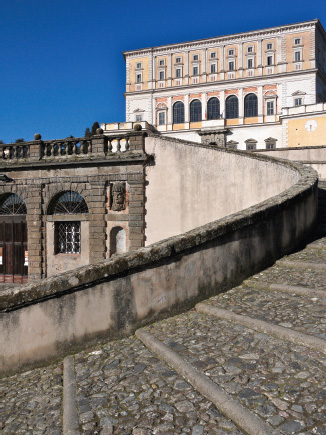![]()
OF PAPAL nipoti of the Cinquecento none had more ruthless political or demanding artistic ambitions than the Farnese, descendants of Pope Paul III. His son Pier Luigi was successively invested with the duchies of Castro and of Parma and Piacenza, which would pass to his own second son, Ottavio. Pier Luigi’s eldest son, Cardinal Alessandro (1520–1589), was the greatest patron of the line, and at Caprarola we still can sense his forceful personality. Jacopo Barozzi da Vignola’s plans for the palazzo were finalized on 31 March 1559, and as you proceed up the spinal street of the small town you are inescapably aware of the magnitude of the cardinal’s intentions.
The villa crowns the ridge as if to challenge the prospect it commands, with the volcanic cone of Mount Soracte rising from the plain and the distant peaks of the Gran Sasso. A great double stair rises to the door in the five-sided substructure, military in aspect, that respected the foundations of the palace which the younger Antonio da Sangallo had begun for the cardinal’s grandfather before his election to the papacy. Vignola’s genius was to create the towering palace above this. His lateral nine-bay main façade, in which the contrasting colours of brick and stone are exploited to signal effect, answers the angle bastions of the Sangallo scheme.
The ground floor is entered though the vestibule, where Federico Zuccaro’s decoration includes the cardinal’s arms and views of the villa and other Farnese possessions. Ahead is the door to Vignola’s masterly circular court at the centre of the building; this is arcaded on two levels, the masonry below channelled while the piers between the upper arches are enriched with paired Ionic pilasters. The door on the left wall of the vestibule opens to Vignola’s beautifully controlled circular staircase, supported on paired columns, the Scala Regia. Decorated in 1580–3 under the supervision of Antonio Tempesta, this leads to the sumptuous apartments of the piano nobile.
The sequence begins with the Salone di Ercole, above the vestibule, the five arches of which are so conspicuous an element of the façade. The arches are answered in the decoration of the room, the murals of which are by members of the équipe brought in when Federico Zuccaro took over the project after the death of his more gifted elder brother, Taddeo, in 1566. Next comes the circular domed chapel, where the frescoes are largely by Federico himself. Beyond is the celebrated Sala dei Fasti Farnesiani, devised by Taddeo at the very end of his life, with scenes celebrating the history of the Farnese, the largest of which show the Troops sent by Paul III to combat the Protestants and King François I receiving the Emperor Charles V and Cardinal Farnese in Paris, with several readily recognizable portraits. The glorification of the Farnese is continued in the adjacent Anti-camera del Concilio, Taddeo’s Proclamation of the Council, which is arguably his most sophisticated fresco in the palazzo. Beyond is the Summer Apartment, hanging over the garden to the north, beginning with the cardinal’s bedroom, the Sala di Aurora, decorated like the two rooms that follow by Taddeo to a programme devised by Annibale Caro. The northern Bartholomäus Spranger worked in the projecting Tower Room at the northern angle of the palace. The Summer Apartment is balanced by that intended for winter use, the Appartamento del’Inverno, with three rooms decorated by Jacopo Bertoia. There follows the Sala degli Angeli, frescoed by two of the most appealing of Mannerist masters, Giovanni dei Vecchi and Raffaellino da Reggio. Both painters also worked with a specialist in cartography, Giovanni Antonio da Varese, in the large Sala del Mappamondo, with maps of the world and territories recently claimed for the Faith, that concludes the sequence of the rooms.
Behind the palazzo a commensurate garden was laid out, with an elegant loggia’d Palazzino del Piacere from which a runnel of water descends to a basin flanked by flights of steps. Grand as this is, the garden must always have lacked the charm of that at Bagnaia.

Jacopo Barozzi da Vignola, Palazzo Farnese.